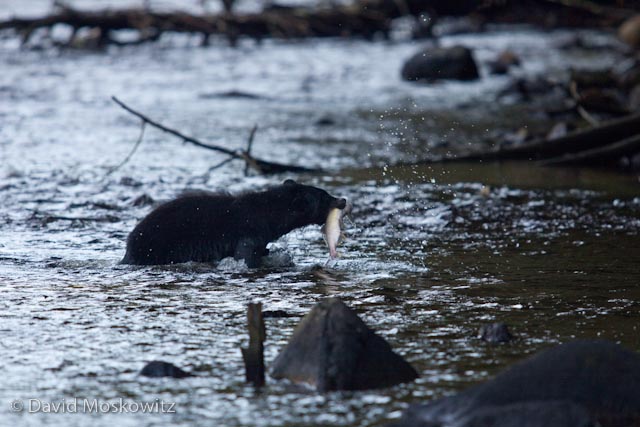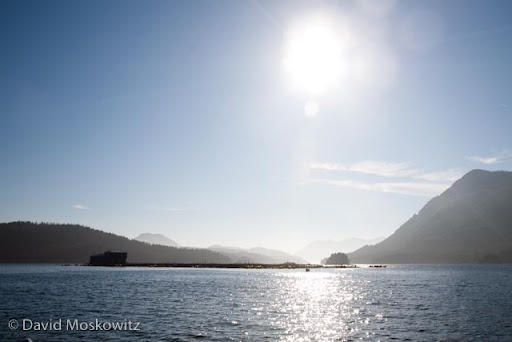Wild salmon, fish farms, and First Nations in British Columbia
16-20: The aroma of rotting salmon
Spent 4 of the last 5 nights out in the field, attaining a sense of oneness with the river, the tides, the migrating salmon, the moss and lichen cloaked trees of the rainforest, the bloodthirsty blackflies, and the ever present aroma of rotting fish carcasses--the good life. Several interesting encounters with wolves which I'm sure will make it into the book.Flying south tomorrow and home the day after. Now that all the field work is completed, I reckon I'll be chained to my computer for the next month and half writing. Don't think I'll be posting daily updates.
15: Getting teased like a raven swooping on a wolf
The remains of a very recent meal of some rainforest wolves on the British Columbia coast.
A raven taunts a wolf in morning fog.
Heavy fog slowed our arrival at field sight. We likely scared them out of the stream when we showed up. Found a ton of headless salmon and a couple laying the grass still flopping. Got a few images of one animal. Heading back out this evening to camp for a few nights in an attempt to be out there at first light without disturbing them! Wish me luck! May be a few days before my next post.A raven taunts a wolf in morning fog.
Day 14: They come in the night
Well, we were right to be hopeful. The wolves came. And the wolves caught and ate salmon. Right in the stream in front of the blind were we were set up to photograph. During the night between when we left at sundown and before we arrived at first light. We did watch one wolf skirt the edge of the meadow we are set up on later in the morning but didn't take any photographs.When we left the pink salmon were literally streaming into the mouth of the creek on the rising tide so we will see what tomorrow holds!
12/13: Go for the eyes
A raven pecks out the eye of a recently expired pink salmon in a shallow stream on the British Columbia coast.
Rain, wind and looming deadline for three chapters of writing kept me in yesterday. Today Doug and I spent most of the day in the location we photographed the pups a week ago. Tons of pinks in the river and we heard howling just as we were packing up to leave at dark. Optimistic about tomorrow!Find out more about my project on Wolves in the Pacific Northwest!
Two men dwarfed by the rainforest they are about to enter. They were out counting fish carcasses along the stream to determine the number of salmon returned thus far for the Heiltsuk Nation’s Fisheries Program.
Day 10: Of fish and bird
Doug enjoying a cup of coffee during the morning commute to the office.
Got 18 species on my bird list for the day including two new ones for the life list, a Black Turnstone and a Surf Bird. Lots of salmon in the streams we visited but the wolves have continued to be scarce.
The Office
The only sign of wolves we found today were a couple of brainless chum salmon.
Chum salmon swimming upstream.
Jumping Coho salmon
Black turnstones
Day 9
View from my blind.
Dinner
A beautiful morning on the same stream I've been at for the past several days. The only wildlife activity was a tiny shrew that scampered in front of my small blind before disappearing into the tall grass. No salmon in the section of stream I was set up on today. Doug's dad, a commercial fisherman had a slightly better catch today, (about 26,000 pounds of salmon better) so I won't be going hungry tonight.
Day 6: Sick of listening to ravens
One of the many ravens lingering along a salmon bearing stream and feeding on the remains of coho killed the day before by wolves.
Spent much of the day back in the same location as yesterday. No wolf activity but the ravens and eagles where quite active further upstream. After three hours of sitting in my makeshift blind I wandered upstream to see what was so interesting and discovered the remains of about a dozen coho that had been killed by wolves the day before (likely around the time we were photographing the pups).For some more images of the area check out the awesome photos of Douglas Brown at his website: www.douglasjbrown.com
More info on my project at: davidmoskowitz.blogspot.com/2010/03/wolves-of-pacific-northwest.html
Day 4: Quiet day on the water
Calm morning water on an inlet north of Bella Bella
Jumping chum salmon are a common sight in the still waters close to fresh water streams at the moment
Day 3: Salmon are spawning!
Spawned out chum salmon in a small stream in the Great Bear Rainforest.
Chum salmon carcass with the top of the head removed by a wolf and a fresh wolf scat besides it.
We discovered a stream in an inlet northeast of Bella Bella today in which the chum salmon have started moving into and spawning. Along the banks close to the mouth we also discovered about a half dozen carcasses that had been fed on by wolves and a couple of fresh scats.
Learn more about my project Wolves in the Pacific Northwest.
Clayoquot Sound, B.C.
Wolf tracks along west coast of Vancouver Island, British Columbia.
Bald eagle above a foggy forest.
Carcass of juvenile humpback whale on beach of island in Clayoquot Sound
Racoon foraging for sand flees on beach of island in Sound
Black-tailed deer feeding on seaweed on island in Clayoquot Sound.
River otter scent marking on seaweed as tide goes out.
Black bear foraging for invertebrates in the intertidal zone by rolling rocks.
Large Sitka spruce in ancient forest on island in the Sound.
A gray wolf trots along the beach early in the morning with ravens in the background. West Coast, Vancouver Island.
Tofino Inlet, Clayoquot Sound.
Harbor seals lounging at low tide.
Atlantic salmon fish farm in Clayoquot Sound with uncut forest in background. Several rivers with no clearcuts or roads in them are seeing massive declines in salmon numbers due to sea lice and other issues associated with fish farming in the Sound. The smell is overwhelming, far worse than a dairy farm and totally shocking in such a wild setting.
Active clearcut logging in Clayquot Sound. Top of the photo is uncut oldgrowth. Bottom is regrowth from a previous clearcut.
Growth rings: over 200. Destination: ?
Huge western red ceder stump set amidst second growth forest of planted Douglas firs. Note that the original nurse log that the ceder tree started growing on in still under the stump, attesting to the volume of biomass in the previous ancient forest and the literally centuries it took to create the structural diversity so important to many Old growth obligate species.
Despite decades of conservation efforts, Clayoquot Sound, a UNESCO Biosphere Reserve, faces numerous severe threats to its ecological integrity including clear cut logging of roadless old growth forests, industrial Atlantic salmon fish farms, and proposed open-pit copper mining. Learn more about the region and how you can support conservation in the region at the following websites:Friends of Clayoquot Sound Clayoquot Biosphere Reserve First Nations Environmental Network








































